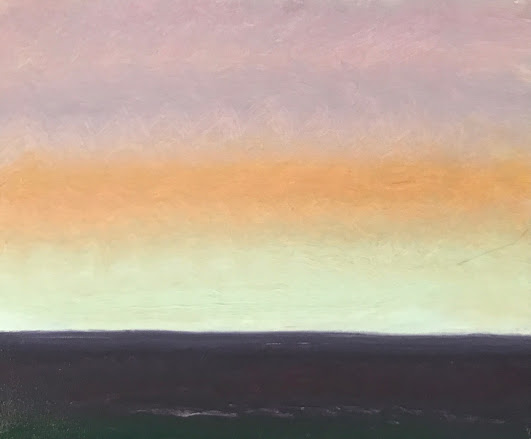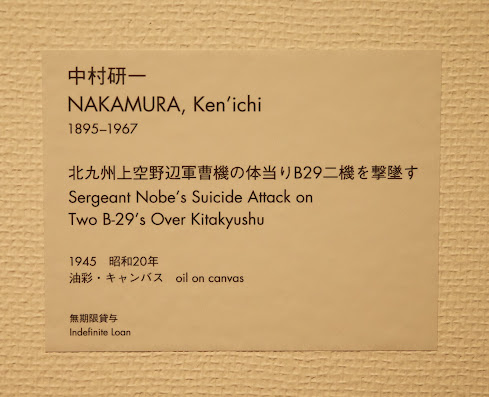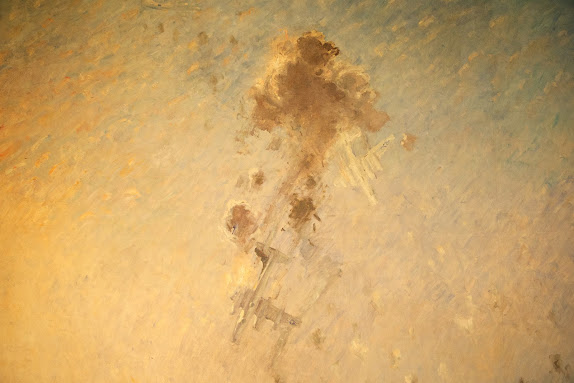Les moutons dans les camions sur la route 1996, oil on canvas, 150 X 150 cm
This is a curious painting from 1998 when I was in the small studio at the Châteaunoir. I was working out in Nature but also in the studio, something I do today in Australia. I haven't eaten red meat since 1980, I stopped within weeks of Reagan's first year in office. That is the marker because in his first year in office he signed a bill to allow cattle farmers to use steroids in the animal feed while he, himself, kept his private herd organic. The mother******! But at the same time, I have had in my blessed life a Vegan friend who didn't eat anything "that would try to get away from him" as he put it, nor would he wear anything leather. He was a great influence upon my thinking.
I had flirted for years with the idea of giving up meat but I guess I saw this as my final opportunity so I did give it up. I remember the day it happened. I was sitting in a famous hamburger place called Jackson Hole on the upper East side. I was reading the paper at the counter when I suddenly looked up at everyone around me. Everybody (including myself) was thick into their tall, rare red hamburgers (This was after all, the go-to-joint for the best burgers on the East side). To my surprise there was a woman next to me eating and smoking at the same time. (man o man, those were the days! cigarettes in coffee shops!) It may be rude and politically incorrect to admit but in a flash, everyone in that place looked really awful to me. They were pale, overweight and on the whole very unhealthy looking. I was 29 at the time but I probably didn't look too good either to be fair. I might say I had an epiphany of sorts, because I put my burger down and swore I would never eat red meat again. I haven't. But I have eaten chicken a few times times since then because I was looking for protein, but that didn't really work out for me either and didn't last. But, I have been eating fish, though that too might be in the outbox soon too.
People have asked me why, especially in France because I lived in a really carnivorous area. It was always a bit awkward at dinner parties. But as I explained not without difficulty that I am always happy "with a salad and simple stuff", then I would meekly tried to change the subject.
"Oh... Vous vous n'inquiétez pas pour moi Madame! une salade me va très bien,,, et,,,, vos chiens sont magnifiques madame!"
Sometimes, I found myself saying the dumbest things in French. And those looks they would give me (!) which I tried to ignore... Ha ha, but after a while, they got used to me, and mostly everything was pretty cool and to my surprise, I was actually invited out quite often.
But when I did give up meat I also became quite casual around food, I would eat some cheese, some bread, noodles, tomato salad, lots of fruit, anything easy, whatever was in the kitchen in fact, and fresh is always best. And I am still like that. But I come from America, and Americans are big people, they wear big clothes, it's a place where meat is the mainstay of a meal yet with time, this idea slipped away the longer I stayed in France.
But then another reason that it was easy to give up meat was because I harboured feelings of affection for animals; cows, their young offspring (disguised as the word veal on menus) And I loved birds, and especially pigs too. I was too aware even then that they were poorly treated, so this too, was a consideration. But why do I eat fish, friends would ask? I responded that I cannot pet them. That is to say that I cannot have relationship with them. But, if push came to shove and I were stranded in the wilderness I would surely eat any meat to stay alive. So this meat thing works both ways; it's a luxury whether you are eating it, or giving it up.
I drove a lot in Europe in those days and I was especially upset when I saw trucks full of pigs and cows transported in awfully crowded conditions. The trucks were emblazoned with bright colours as if in celebration. Large pink pigs were painted wearing the iconic white chef's hat and waving to cars on the autoroutes all over Europe, and beyond. Of course it seemed ludicrous but understandable. These happy creatures could not be seen as prosciutto.
And in today's world, still a tricky consumer world to navigate, where animal conditions have deteriorated further, (and continue to do so) where large conglomerates seem to dictate the diets for too many people in the Western world,
(Don't mention what's actually in Chicken McNuggets) it seems like an easy choice to give up meat and so I am so very grateful I did.
So now forty two years later, in today's world it's completely different. Vegans rule! One can navigate mostly anywhere to get a vegetarian meal (except Spain and the Middle East). It's new world I am grateful today.
This is the backdrop for the painting above, and I am sorry for the pedantic rambling about all this, and which may be completely uninteresting to all the carnivores out there who will think secretly to themselves: "This diet has made this guy barking mad!! I am sticking with meat!"
Anyway, I am surprised at how easily I can go off on such tangents, but this is the context behind the work, the backdrop for the context more precisely. I wanted to see if I could depict a painting that expressed so much of what I felt in pictorial terms. I guess this is still one of the holy grails for a painter. But during those years I only worked in sepia tones and black because I imagined that it was simpler at the time, but in fact, I now know that it's because I was afraid of working in colour on such a large scale. I was basically afraid I would fail because colour implies so much, and I wasn't at the time ready for it. During this time I also made a series of paintings about the Bosnian War and the siege of Sarajevo also using black and dark browns.















